Introduction
Carnauba (Copernicia prunifera) waste is an agro-industrial waste generated by the extraction of wax from the leaves of this palm. This material demonstrates great potential as a mulch for use in radiation, reflecting up to 3000 hours of sunlight per year (Jetter and Kunst 2008).
The short-term benefits of using plant waste material as mulch can be observed through changes in the thermal and water regimes of the soil. This is because mulch creates a favorable microclimate for crops by maintaining humidity and reducing soil temperature fluctuations (Zwirtes et al. 2017; Zribi et al. 2015).
Sousa et al. (2017) stated that when carnauba straw is used as ground cover, it reflects part of the solar energy received by the soil. This considerably reduces gas exchange between the soil and atmosphere, thereby decreasing soil moisture loss and maximizing water use by plants.
Increased soil organic matter content is an additional important benefit gained from utilizing carnauba waste. This subsequently elevates soil fertility and improves its physical properties (i.e., moisture retention, greater porosity, and greater aeration), favoring root system development (Gonçalves et al. 2019). The incorporation of organic matter on the soil surface from plant material, under different treatment and manipulation processes, helps to create and maintain favorable microclimate conditions to establish and support a healthy microbial community in the soil (Yan et al. 2020).
Despite low representation, carnauba waste is currently being used to improve soil temperature and moisture conditions (Souza et al. 2016), increase organic matter content, and enhance soil fertility (Albano et al. 2017).
The objective of this study was to verify the effect of three years of successive application of carnauba waste on the chemical, physical, and biological attributes of a sandy loam, Yellow-Red Oxisol.
Material and methods
The experiment was carried out under field conditions of the Technical College of Teresina at the Federal University of Piauí in Piauí, Brazil (5°2'58,48"S; 42°46'57,13"W; 86 m of altitude). The Köppen climate classification characterizes the regional climate of this area as dry tropical with two distinct seasons: rainy summers and dry winters. The annual average temperature is 30 °C and the annual average rainfall is 1200 mm. The Brazilian System of Soil Classification categorizes the soil of the area as a Yellow-Red Oxisol
with 90 g kg-1 clay, 110 g kg-1 silt, and 800 g kg-1 sand at a depth of 0–20 cm.
The experiment was carried out from 2018 to 2020 with an annual application of 10 t ha-1 of carnauba waste [Left on the surface of the ground or incorporated into the ground layer of 10 cm with the help of a hoe, and in isolation or combined with NPK (recommended dose of synthetic fertilizers; 100:180:86 kg ha-1 NPK)], in which there were six experimental treatments: 1) NPK; (2) surface application of 10 t ha-1 carnauba waste; (3) incorporation of 10 t ha-1 carnauba waste; (4) surface application of 10 t ha-1 carnauba waste + NPK; (5) incorporation of 10 t ha-1 carnauba waste + NPK; and (6) bare and unfertilized soil (the control). The carnauba waste used in this study was manually homogenized to obtain a uniform and representative composite sample. Subsequently, the material was dried in a forced ventilation oven (Fig. 1) at 65 °C for 48 hours and analyzed to determine its chemical composition (Table 1).
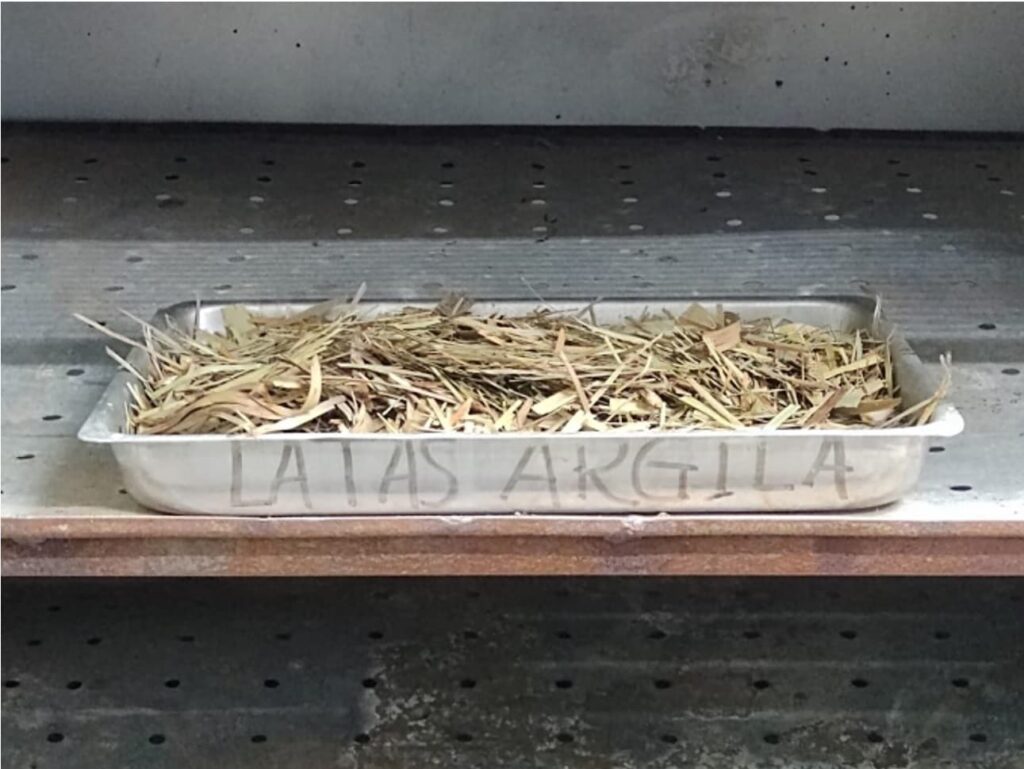
Fig. 1 Carnauba waste dried in a forced ventilation oven
For each experimental plot (2.0 m x 5.0 m, Fig. 2), the temperature and soil moisture were measured at depths of 0.0-0.1 m and 0.1-0.2 m. To measure temperature, a digital thermometer with a measurement range of -50°C to +300°C and a precision of ±1°C was used and inserted in the center of the plot. Soil moisture (%) was calculated from samples collected at five points within the plot. After soil sampling, the samples were weighed and dried at 105°C for 24 h to determine the soil moisture level according to Teixeira et al. (2017).
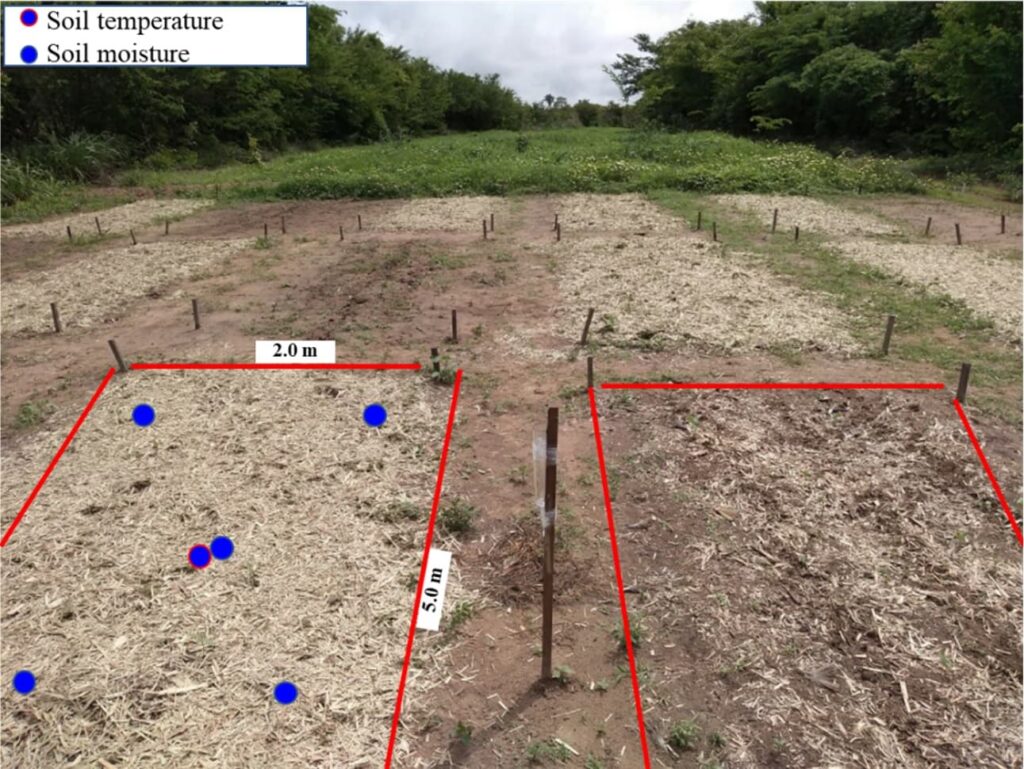
Fig. 2 Experimental area showing experiment plots with carnauba waste (applied on the soil surface or incorporated into the soil, alone or combined with NPK) in reference to uncovered and unfertilized soil (control) and use of mineral fertilizer with NPK
Table 1 Chemical composition of carnauba waste
Components | Unit | Carnauba waste |
C | (%) | 51.5 |
N | g kg -1 | 12.6 |
P | g kg -1 | 0.8 |
K | g kg -1 | 3.8 |
Ca | g kg -1 | 1.9 |
Mg | g kg -1 | 2.3 |
S | g kg -1 | 2.2 |
Zn | mg kg -1 | 8.0 |
Mn | mg kg -1 | 172.0 |
Fe | mg kg -1 | 126.0 |
Cu | mg kg -1 | 28.0 |
B | mg kg -1 | 6.0 |
pH CaCl2 | - | 5.6 |
Relation C/N | - | 40.8 |
From 2018 to 2020, the cultivation of cowpea was carried out in all experimental plots. Following the harvest of the cowpea plants, four soil samples were collected from each plot at depths of 0.0–0.1 m and 0.1–0.2 m, sieved through a 2 mm mesh, stored at 4 °C for soil biological analysis, and air-dried for chemical analysis. Undisturbed soil samples were also collected to determine bulk density using the volumetric ring method. Total organic carbon (TOC) was determined using the wet combustion method which used a mixture of 5 mL of 0.167 mol L-1 potassium dichromate and 7.5 mL of concentrated sulfuric acid under heat (170 °C for 30 min). The carbon stock in each evaluated soil layer was estimated according to the expression proposed by Freixo et al. (2002).
Soil microbial biomass carbon (MBC) was determined using the microwave irradiation extraction method (Islam and Weil 1998). Soil respiration (SR) was monitored with measurement of CO2 evolution under aerobic incubation at 25 °C for 7 days (Alef and Nannipieri 1995). The metabolic quotient (qCO2; mg CO2 kg-1 MBC d-1) was calculated from the SR/MBC ratio, and the microbial quotient (qMic; %) was calculated from the MBC/TOC ratio (Anderson and Domsch 1993).
Data normality was analyzed using the Shapiro–Wilk test, while data homoscedasticity was verified using Leven’s test. After the data underwent analysis of variance, and significance was verified by the F test, the Scott–Knott test was conducted at a level of 5% probability (p<0.05). The data were subjected to multivariate analysis using Principal Component Analysis (PCA). PCA was performed using the Vegan package (Oksanen et al. 2021), and R software, version 4.1.0 (R Core Team 2021) was used to perform statistical tests and prepare the graphics.
Results and discussion
Analysis of the chemical composition of the carnauba waste showed that its nutrient content made it suitable for use as a soil conditioner according to the Brazilian Ministry of Agriculture, Livestock, and Food Supply Normative Instruction 25/2009 (Table 1). The high levels of macronutrients and organic carbon in carnauba waste highlight its ability to contribute to plant nutrition and restore fertility in degraded soils. Oliveira et al. (2018) also conducted a chemical composition analysis of carnauba waste and found that it had a high organic carbon content (161.6 g kg-1).
Treatments that included carnauba waste alone or in combination with NPK contributed to increased TOC content in the soil at both analyzed depths (Fig. 3A). Thus, a positive correlation was observed between the deposition of plant waste materials, such as straw and other types of mulch, and an increase in soil organic carbon content (Santos et al. 2012).
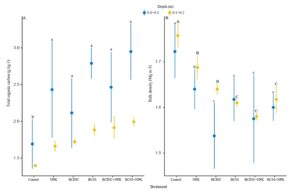
Fig. 3 Plot of the total organic carbon (A) and bulk density (B) in soil cultivated under carnauba waste (applied on the soil surface or incorporated into the soil, and in isolation or combined with NPK) in reference to bare and unfertilized soil (control) and use of mineral fertilizer with NPK
BCINC: carnauba waste incorporated into the soil; BCSS: carnauba waste applied to the soil surface; all treatments with waste received 10 t ha-1. Values followed by different lowercase letters or capital letters in plot indicate significant differences according to Scott-Knott test (p <0.05)
Carnauba waste is rich in high-density carbon fractions (e.g., ligninic compounds and polyphenols), which have complex carbon chains; this means carnauba waste is a material with a high C/N ratio (>40), based on the analysis carried out in this research. This high C/N ratio implies a delay in decomposition, regardless of whether this material is applied to the soil surface or incorporated into the soil column. Santoja et al. (2015) showed that when the C/N ratio in organic waste exceeded 30, nutrient immobilization was the predominant process and decomposition only intensified after 60 d. Souza et al. (2018) concluded that mulching with sorghum straw, characterized by a high C/N ratio, was an effective means of increasing the soil organic carbon content during the four months of the crop cycle. The results of this study show an incremental increase in SOC content during the second year of carnauba waste utilization. However, carnauba waste should generally be applied in combination with NPK. This is probably because straw has a low nitrogen concentration, which means that many of the straw C/N decomposers are internal C/N decomposers that initially immobilize the existing nitrogen in the straw and soil solution to adjust this relationship (Santos et al. 2012). The high C/N ratio of carnauba waste results in the persistence of waste in the soil during the primary stage of decomposition for a longer period than that observed under normal conditions (C/N <30) (Jin et al. 2020) when mineralization is almost null. As such, a significant increase in TOC would only be observed in 2-5 years, when the N needs of some of the microbial communities were met and maintained, and the mineralization process became predominant (Guo et al. 2019). A study integrating straw and fertilizer plots showed that this combination contributed to increase soil organic carbon, dissolved carbon, and labile organic carbon content by approximately 1.2–2.9 times compared to that of the control plot (Akhtar et al. 2019). They also observed an increase of 28% in available nitrogen, 45% in phosphorus, and 55% in potassium. These improvements in soil fertility and carbon indices increased soybean biomass and grain yield by 67% and 75%, respectively, over the 3-year study period. Treatment with carnauba waste resulted in a reduced bulk density (Fig. 3B). The control treatment had a bulk density exceeding the critical limit (1.53-1.72 Mg m-3) for sandy soils, as recommended by Reichert et al. (2003). Yang et al. (2018) reported that the combined application of corn waste and chemical fertilizer improved soil structure, reduced soil density, and enhanced water storage to a greater extent. The highest carbon stock values occurred in treatments subjected to carnauba waste application on the soil surface, alone or in combination with NPK in the surface layer (i.e., treatments 2 and 4; Table 2). In terms of treatments receiving subsurface application of carnauba waste (i.e., treatments 3 and 5), treatment 4 had the highest carbon stock values.
Table 2 Soil organic carbon stocks (SOC stocks) under carnauba waste (applied on the soil surface or incorporated into the soil, and in isolation or combined with NPK) in reference to bare and unfertilized soil (control) and use of mineral fertilizer with NPK
Treatments* | Carbon stock (Mg C ha-1) | Total carbon stock (Mg C ha-1) | |
0.0-0.1 m | 0.1-0.2 m | 0.0-0.2 m | |
BCSS | 45.38 a | 31.41 a | 76.80 |
BCINC | 39.74 b | 28.09 b | 67.83 |
BCSS+ NPK | 47.13 a | 32.26 a | 79.39 |
BCINC+NPK | 38.48 b | 30.57 a | 69.05 |
NPK | 32.57 c | 28.05 b | 60.63 |
Control | 29.25 c | 24.53 b | 53.78 |
* BCINC: carnauba waste incorporated into the soil; BCSS: carnauba waste applied to the soil surface; all treatments with waste received 10 t ha-1. Values followed by different letters in columns indicate significant differences according to Scott-Knott test (p <0.05).
However, the control and NPK treatments (i.e., treatments 1 and 6) had carbon stock values well below this variable, particularly in the soil surface layer. Using the control and NPK treatments as a reference, there was an increase of approximately 15 Mg ha-1 of carbon stock in the soil in treatments 2 and 4. These treatments exhibited the highest values of this variable, particularly in the 0–0.10 m layer. These results demonstrate the effectiveness of carnauba waste in regulating the entry and exit of carbon in soil and, thus, increasing the carbon stock in intensively cultivated soils over a short period. Prior to this type of soil management, this area had been managed using conventional techniques for approximately 20 years with the use of agricultural implements and annual crops. This type of management contributes to the breakdown of soil aggregates and exposure of organic matter, which accelerates oxidation and culminates in lower TOC levels, particularly in sandy-textured soils (Freitas et al. 2018).
In general, there were increases in MBC values when carnauba waste was added alone or in combination with NPK in the 0.0–0.1 m layer. In the subsurface layer, the treatments receiving the surface application of carnauba waste had higher MBC values (Fig. 4A). The deposition of plant residues in soil stimulates microbial biomass, prompting an increase in microbial abundance and activity. In addition to increasing substrate availability, these residues provide adequate soil conditions for microorganisms. Specifically, residues lower soil temperature and enhance soil moisture conservation (Moreira and Siqueira 2006).
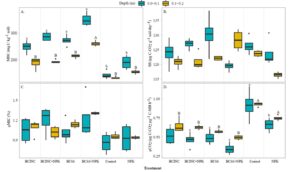
Fig. 4 Boxplot of the microbial biomass carbon (A), soil respiration (B), metabolic quotient (C) and microbial quotient (D) in soil cultivated under carnauba waste (applied on the soil surface or incorporated into the soil, and in isolation or combined with NPK) in reference to bare and unfertilized soil (control) and use of mineral fertilizer with NPK
BCINC: carnauba waste incorporated into the soil; BCSS: carnauba waste applied to the soil surface; all treatments with waste received 10 t ha-1. Values followed by different lowercase letters or capital letters in box’s indicate significant differences according to Scott-Knott test (p <0.05).
MBC is recognized as a key indicator of soil quality and is generally associated with the quantity and quality of carbon sources. The results verify that the application of carnauba waste in combination with NPK facilitates the availability of organic matter to soil microbes following the continuous and successive applications of this material.
At a depth of 0.1–0.2 m, only treatments receiving carnauba waste combined with NPK (i.e., treatments 4 and 5) caused an increase in MBC. Materials with a high C/N ratio undergo slower decomposition because low nitrogen availability may harm the development of the incoming soil microbial community via competition between microbial biomass and plant roots (Assis et al. 2003).
It is postulated that this occurred because the nitrogen present in this waste was insufficient for the straw to decompose; thus, it became a limiting factor. Despite the short period during which microbial immobilization of nitrogen and other nutrients occurs in the soil, this process renders these nutrients unavailable to plants. Therefore, nitrogen application may reduce this effect during the microbial decomposition of wastes with a high C/N ratio because when nitrogen is applied together with straw, it assumes the role of a nutritional supplement, which increases microbial decomposition (Wang et al. 2020).
In this study, there was no difference in qMic between treatments for the two soil layers (Fig. 4C); however, qMic in all treatments receiving carnauba waste was >1%, demonstrating the extent of environmental stability. Silva et al. (2012) reported that qMic values of <1% occur because of possible limiting factors related to microbial activity.
The respiration values for treatments receiving carnauba waste (i.e., treatments 2–5) did not statistically differ from those of the control, at both depths (i.e., 0.0–0.1 m and 0.1–0.2 m; Fig. 4B). However, respiratory activity must be carefully interpreted, as these values may result from the accumulation of organic matter concentrated in the labile fractions (i.e., carbohydrates, nitrogen compounds, and microbial biomass and its metabolites) of the soil surface, which are susceptible to decomposition.
However, microbial respiration may also reflect the intense consumption of oxidizable carbon by the microbial community for maintenance, particularly when this community is under stress. Therefore, it is important to consider the respiration rate per unit of biomass (i.e., qCO2) when investigating soil quality, because differences between various soil management types may not be detected when microbial respiration alone is evaluated.
The qCO2 values obtained for the treatments receiving carnauba waste (i.e., treatments 2–5) at the two depths were significantly lower (Fig. 4D). This shows an environment experiencing a lower degree of disturbance or stress when there is a surplus of organic production in relation to respiration, according to the theory of “Bioenergetic Development of Ecosystems” proposed by Odum (1969). This theory emphasizes that microbes may vary greatly in their rate of replacement metabolism depending on environmental conditions. In contrast, microbial communities experiencing unfavorable conditions tend to have higher qCO2 values, reflecting a greater influx of energy (carbon) through soil microbial biomass (Lacerda et al. 2013).
In terms of soil moisture, which was evaluated in the surface layer during the experiment, the treatments that received carnauba waste (i.e., treatments 2–5) showed higher soil moisture levels throughout the experiment (Fig. 5). Conversely, treatments without carnauba waste (treatments 1 and 6) had lower soil moisture levels. This is likely a result of the sandy texture of the soil and the absence of waste, which attenuates the effects of solar radiation on water evaporation.
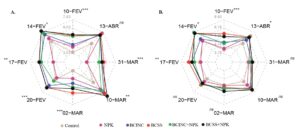
Fig. 5 Average soil moisture at depths of 0.0-0.1 m (A) and 0.1-0.2 m (B) in soil cultivated under carnauba waste (applied on the soil surface or incorporated into the soil, and in isolation or combined with NPK) in reference to bare and unfertilized soil (control) and use of mineral fertilizer with NPK
BCINC: carnauba waste incorporated into the soil; BCSS: carnauba waste applied to the soil surface; all treatments with waste received 10 t ha-1. The light gray line shows the average variation scale of the variables. ns, not significant; *, p < 0.05; **, p < 0.01; ***, p < 0.001.
In general, soil moisture content increased with depth. In the layer between 0.0 m and 0.1 m (Fig. 5A), the soil moisture levels remained below 8% in most observations, while between 0.01 m and 0.02 m depths (Fig. 5B), moisture levels were approximately 10%. The effect of carnauba waste on soil moisture was more significant in the surface layer.
The treatments receiving the surface application of carnauba waste (i.e., treatments 2 and 4) exhibited the highest moisture values, likely because of the greater soil protection provided by this material. This shows that such waste absorbs rays from the sun, attenuating gas exchange between the soil surface and the atmosphere, thus promoting a reduction in water vapor loss. This is consistent with the findings of Oliveira et al. (2002). In their evaluation of the fruit production system in northeast Brazil, they advocated the use of carnauba waste as a covering material because of its ability to cool the soil and minimize gas exchange between the soil and the atmosphere. Sousa et al. (2017) conducted research using sandy loam soil and carnauba waste mulch and concluded that this material improved the water retention capacity by maintaining soil moisture for a longer duration. Souza et al. (2016) showed that the ground covered with carnauba waste was effective in retaining water in the soil and inhibiting the emergence of weeds. The moisture values for the 0.1–0.2 m layer also differed between treatments for a smaller number of observations and at the beginning of the experiment. This may have occurred because the leaf area index during the initial cultivation stages of the bean crop was low; as such, the soil received more direct solar energy, leading to increased water evaporation, which was elevated because of the sandy texture of the soil. At the end of the experiment, there was no difference in soil moisture content because of the higher average temperature and lower rainfall quantities recorded during this period (Fig. 5).
As previously verified, when carnauba waste is placed on the soil surface, it acts as a barrier that preserves a greater amount of available water up to a depth of 0.2 m. This indicates that this material is similar to other
straws in that it creates favorable microclimate conditions such that the available water may be used more efficiently and over a longer duration when compared to the soil in which this material was incorporated or not used at all. The use of wheat straw mulch and nitrogen fertilizer increased soil moisture by 23% and decreased soil temperature by 8% compared to the control at 0–0.2 m depths (Akhtar et al. 2019). The surface application and incorporation of carnauba waste significantly reduced (p<0.001) the thermal amplitude of soil up to a depth of 0.2 m (Fig. 6). This is attributed to a change in the radiation balance caused by soil management. Because soil temperature is a dynamic property, how it is positively or negatively affected by air temperature fluctuations over several days is strongly correlated with the type of management adopted within a given area (Awe et al. 2015). In this study, carnauba waste contributed positively to the attenuation of radiation absorbed by the soil. This enabled the creation of microclimatic conditions favorable for the growth of microbes and plant development throughout the experimental period.
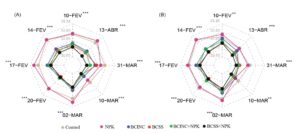
Fig. 6 Average temperature at depths of 0.0–0.1 m (A) and 0.1–0.2 m (B) in soil cultivated under carnauba waste (applied on the soil surface or incorporated into the soil, and in isolation or combined with NPK) in reference to bare and unfertilized soil (control) and use of mineral fertilizer with NPK
BCINC: carnauba waste incorporated into the soil; BCSS: carnauba waste applied to the soil surface; all treatments with waste received 10 t ha-1. The light gray line shows the average variation scale of the variables. ns, not significant; **, p < 0.01; ***, p < 0.001.
At depths of 0.0–0.1 m (Fig. 6A), there was a reduction in soil temperature of up to 3 ℃. The lowest temperature observed at this depth (30.6 ℃) was recorded in treatments receiving only surface applications of carnauba waste (i.e., treatments 2 and 4), whereas the highest temperature (33.6 °C) was associated with the control and NPK treatments (i.e., treatments 1 and 6). This result is in agreement with those of Liu et al. (2014) who evaluated temperature fluctuations in soil subject to coverage using rice straw and wheat in a citrus orchard over 2 years. They concluded that such coverage resulted in a soil temperature reduction of 1.5 °C. Carnauba waste reflects part of the solar radiation that it receives and possesses low thermal conductivity owing to the porous spaces formed between the piles of straw deposited on the soil. This explains the efficiency of this material as a thermal insulator. Furthermore, soils that did not receive any type of cover (i.e., treatments 1 and 6) or those in which carnauba waste
was incorporated (i.e., treatments 3 and 5) absorbed a greater amount of solar radiation throughout the day, leading to higher soil temperatures. At depths between 0.1 m and 0.2 m (Fig. 6B), the soil temperature reduction observed for treatments 2 and 5, compared to treatments 1 and 6, was 1.5 ℃. However, the maximum temperature reduction recorded at these depths was 2 °C lower (32 °C) than that recorded at depths of 0.0–0.1 m (34 °C). Soil temperature was higher at the surface, mainly in the first 5 cm, which was the cause of the reductions in soil temperature averages in the subsurface layer. Similar to that observed at 0.0–0.1 m, treatments 2 and 4 recorded the lowest temperatures, followed by the treatments incorporating carnauba waste (i.e., treatments 3 and 5), and the NPK and control treatments (i.e., treatments 1 and 6).The PCA was performed on a data matrix consisting of seven variables for both depth ranges (Fig. 7). The percentage of variance explained by the principal components showed that, in the surface layer, the first two principal components were responsible for 71.7% of the original variability, with CP1 and CP2 contributing 53% and 18.7%, respectively.
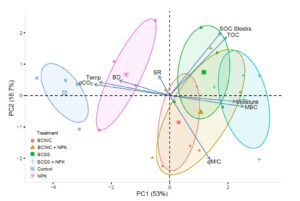
Fig. 7 Microbial biomass carbon (MBC), soil respiration (SR), bulk density (BD), total organic carbon (TOC), soil organic carbon stocks (SOC stocks), metabolic quotient (qCO2), microbial quotient (qMic) and temperature (Temp) and soil moisture, collected at a depth of 0.0–0.1 m, and cultivated under carnauba waste (applied on the soil surface or incorporated into the soil, and in isolation or combined with NPK) in reference to bare and unfertilized soil (control) and use of mineral fertilizer with NPK
BCINC: carnauba waste incorporated into the soil; BCSS: carnauba waste applied to the soil surface; all treatments with waste received 10 t ha-1.
All treatments with carnauba waste were associated with organic and microbial carbon, respiration, qMic, and soil moisture.
This is due to the wax present in this material that can reflect solar energy when applied on the soil surface, thereby preventing water loss by evaporation. In addition, the maintenance of organic material on the soil surface serves as a source of energy for microbes, promoting an increase in MBC (Moreira and Siqueira 2006). In contrast, the control and NPK treatments
(i.e., treatments 1 and 6), which did not receive any additional carbon source, showed a relationship with qCO2, temperature, and soil density. The high values of these variables are indicative of poor soil quality. At depths of 0.1–0.2 m, the percentage of variance was 68.8% of the original variability, with CP1 and CP2 contributing 48.8% and 21%, respectively (Fig. 8).
At this depth, only treatment 4 was more closely related to MBC, TOC, and soil moisture, which were positioned in the upper-right quadrant. Treatments 2 and 3 were associated with SR. It was also verified that all treatments receiving carnauba waste were associated with respiration, qMic, and carbon stock. Treatments 1 and 6 exhibited the same behavior in the surface layer.
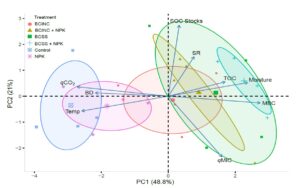
Fig. 8 Microbial biomass carbon (MBC), soil respiration (SR), bulk density (BD), total organic carbon (TOC), soil organic carbon stocks (SOC stocks), metabolic quotient (qCO2), microbial quotient (qMic) and temperature (Temp) and soil moisture, collected at a depth of 0.1–0.2 m, and cultivated under carnauba waste (applied on the soil surface or incorporated into the soil, and in isolation or combined with NPK) in reference to bare and unfertilized soil (control) and use of mineral fertilizer with NPK
BCINC: carnauba waste incorporated into the soil; BCSS: carnauba waste applied to the soil surface; all treatments with waste received 10 t ha-1.
A third group was formed by the NPK and control treatments (i.e., treatments 1 and 6), which had a relationship with temperature, CO2, and soil density.
This is because these treatments experienced an increase in soil temperature and a decrease in soil moisture levels.
The absence of organic cover reduced energy sources for microbial activity, in turn affecting the formation of soil aggregates.
This has a direct impact on soil density (Qui et al. 2020). Furthermore, aggregate surfaces in soils not covered by carnauba waste were readily dispersed under the erosive forces of raindrops.
Conclusion
This study concluded that the use of carnauba residue combined with fertilizer can improve the microbiological attributes of the soil, increase the organic carbon content in the soil, and reduce the thermal amplitude, which can help maintain higher levels of moisture in the soil. The use of carnauba residue as a fertilizer is a sustainable practice because it utilizes waste that might otherwise be discarded. Moreover, this study suggests that it may be possible to reduce the amount of synthetic fertilizer required by combining it with carnauba residue, which could have positive environmental implications. However, further research is required to confirm these findings and determine the long-term effects of this approach.
Acknowledgment
The authors are indebted to Technical College of Teresina, for the support received during the conduct of experiment. This study was financed in part by the Coordenação de Aperfeiçoamento de Pessoal de Nível Superior (CAPES) from Brazil.
Compliance with ethical standards
Conflict of interest The authors declare that there are no conflicts of interest associated with this study.
Open Access
This article is distributed under the terms of the Creative Commons Attribution 4.0 International License (http://creativecommons.org/licenses/by/4.0/), which permits unrestricted use, distribution, and reproduction in any medium, provided you give appropriate credit to the original author(s) and the source, provide a link to the Creative Commons license, and indicate if changes were made.
References
Akhtar K, Wang W, Ren G, Khan A, Feng Y, Yang G, Wang H (2019) Integrated use of straw mulch with nitrogen fertilizer improves soil functionality and soybean production. Environ Intern 132:92-105. https://doi.org/10.1016/j.envint.2019.105092
Albano FG, Cavalcante IHL, Machado JS, Lacerda CF, Silva ER, Sousa HG (2017) New substrate containing agroindustrial carnauba residue for production of papaya under foliar fertilization. Rev Bras Eng Agrí Ambient 21:128-133. https://doi.org/10.1590/1807-1929/agriambi.v21n2p128-133
Alef K, Nannipieri P (1995) Methods in soil microbiology and biochemistry. Academic, New York, NY
Anderson JPE, Domsch KH (1993) The metabolic quotient (qCO2) as a specific activity parameter to asses the effects of environmental conditions, such as pH, on the microbial biomass of forest soils. Soil Biol Bioch 25:393-395. https://doi.org/10.1016/0038-0717(93)90140-7
Assis EPM, Cordeiro MAS, Paulino HB, Carneiro MAC (2003) Efeito da aplicação de nitrogênio na atividade microbiana e na decomposição da palhada de sorgo em solo de cerrado sob plantio direto. Pesq Agrop Trop 33:107-112
Awe GO, Reichert JM, Wendroth OO (2015) Temporal variability and covariance structures of soil temperature in a sugarcane field under different management practices in southern Brazil. Soil Till Res 150:93–106. https://doi.org/10.1016 / j.still.2015.01.013
Freitas L, Oliveira IA, Casagrande JC, Silva LS, Campos MCC (2018) Estoque de carbono de Latossolos em sistemas de manejo natural e alterado. Ciênc Flor 28:228-239. http://dx.doi.org/10.5902/1980509831575
Freixo AA, Machado PLOA, Guimarães CM, Silva CA, Fadigas FS (2002) Estoque de carbono e nitrogênio e distribuição de frações orgânicas de Latossolo do cerrado sob diferentes sistemas de cultivo. Rev Bras Ciênc Solo 26:425-434. https://doi.org/10.1590/S0100-06832002000200016
Gonçalves MPM, Silva MIO, Grugik MA, Feliciano ALP, Silva LB (2019) Substratos alternativos na produção de mudas de Harpalyce brasiliana BENTH. Oecol Aust 23:464-472. https://doi.org/10.4257/oeco.2019.2303.06
Guo Z, Han J, Li J et al (2019) Effects of long-term fertilization on soil organic carbon mineralization and microbial community structure. PLoS One 14:1–16.
https://doi.org/10.1371/journal.pone.0211163
Islam KR, Weill RR (1998) Microwave irradiation of soil for routine measurement of microbial biomass carbon. Biol Fertil Soils 27:408-416. https://doi.org/10.1007/s003740050451
Jetter R, Kunst L (2008) Plant surfasse lipid biosynthetic pathways and their utility for metabolic engineering of waxes and hydrocarbon biofuels. Plant J 54:670-683. https://doi.org/10.1111/j.1365-313X.2008.03467.x
Jin Z, Shah T, Zhang L, Liu H, Peng S, Nie L (2020) Effect of straw returning on soil organic carbon in rice–wheat rotation system: A review. Food Energy Secur 9:1-13. https://doi.org/10.1002/fes3.200
Lacerda KAP, Cordeiro MAS, Vergtinassi A, Salgado FHM, Paulino HB, Carneiro MAC (2013) Organic carbon, biomass and microbial activity in an Oxisol under different management systems. Amazonian J Agric Environ Sci 56:249-254. https://doi.org/10.4322 / rca.2013.036
Liu Y, Wang J, Liu D, Li Z, Zhang G, Tao Y, Chen F (2014) Straw mulching reduces the harmful effects of extreme hydrological and temperature conditions in Citrus Orchards. Plos One 9:1 e87094. https://doi.org/10.1371/journal.pone.0087094
Moreira FMS, Siqueira JO (2006) Microbiologia e bioquímica do solo. 2.ed. Lavras: Editora UFLA 729 p
Odum EP (1969) The strategy of ecosystems development. Science, 164:262-270
Oksanen J, Blanchet FG, Friendly M, Kindt R, Legendre P, McGlinn D, Minchin PR, O'Hara RB, Simpson GL, Solymos P, Stevens MHH, Szoecs E, Wagner H (2021) Vegan: Community Ecology Package. R package version 2.5-7
Oliveira FNS, Lima AAC, Aquino ARL, Maia SMF (2002) Influência da cobertura morta no desenvolvimento de fruteiras tropicais. Fortaleza: Embrapa Agroindústria Tropical 24p
Oliveira LS, Costa MCG, Souza HA, Blum J, Albuquerque GHS, Abreu MGP, Maia DS (2018) Characterization of organic wastes and effects of their application on the soil. J Agric Sci 10:291-298. https://doi.org/10.5539/jas.v10n6p291
Qui Y, Lv W, Wang X, Xi Z, Wang Y (2020) Long-term effects of gravel mulching and straw mulching on soil physicochemical properties and bacterial and fungal community composition in the Loess Plateau of China. European J Soil Biol 98:103-108. https://doi.org/10.1016/j.ejsobi.2020.103188
R Core Team R (2021) A language and environment for statistical computing. Vienna: R Foundation for statistical computing
Reichert JM, Reinert DJ, Braida JA (2003) Qualidade dos solos e sustentabilidade de sistemas agrícolas. Ci Amb, 27:29-48
Santoja M, Fernandez C, Gauquelin T, Baldy V (2015) Climate change effects on litter decomposition: Intensive drought leads to a strong decrease of litter mixture interactions. Plant Soil 393:69-82. https://www.jstor.org/stable/43872155
Santos VB, Araújo ASF, Leite LFC, Nunes LAPL, Melo WJ (2012) Soil microbial biomass and organic matter fractions during transition from conventional to organic farming systems. Geoderma 170:227–231. https://doi.org/10.1016/j.geoderma.2011.11.007
Silva CF, Pereira MG, Miguel DL, Feitosa CF, Loss A, Menezes CEG, Silva EMR (2012) Carbono orgânico total, biomassa microbiana e atividade enzimática do solo de áreas agrícolas, florestais e pastagem no médio Vale do Paraíba do Sul (RJ). Rev Bras Ciên Solo 36:1680-1689. https://doi.org/10.1590/S0100-06832012000600002
Sousa PGR, Sousa JPF, Sousa AM, Costa RNT (2017) Produtividade do mamoeiro cultivado sob aplicação de cinzas vegetais e bagana de carnaúba. Rev Bras Agric Irrig 11:1201-1212. https://doi.org/10.7127/rbai.v11n100565
Souza AAL, Moreira FJC, Araújo BA, Lopes FGN, Silva MES, Carvalho BS (2016) Desenvolvimento inicial de duas variedades de alface em função de dois tipos de substratos e cobertura do solo. Brazilian J Biosys Engin 10:316-326. https://doi.org/10.18011/bioeng2016v10n3p316-326
Souza TEMS, Gonçalves EP, Pereira DS, Santos LM, Machado LS, Souza ER (2018) Redução da erosão em cultivo de sorgo com cobertura morta. Caatinga 31:730-736
Teixeira PC, Donagemma GK, Fontana A, Teixeira WG (2017) Manual de métodos de análise de solo. 3. ed. rev. e ampl. Brasília: Embrapa; Rio de Janeiro: Embrapa Solos
Wang Q, Cao X, Jiang H, Guo Z (2020) Straw application and soil microbial biomass carbon change: A Meta‐Analysis. CLEAN-Soil Air Water 49:1-7. https://doi.org/10.1002/clen.202000386
Yan S, Song J, Fan J, Yan C, Dong S, Ma C, Gong Z (2020) Changes in soil organic carbon fractions and microbial community under rice straw return in Northeast China. Global Ecol Conserv 22:62-74. https://doi.org/10.1016/j.gecco.2020.e00962
Yang Y, Wu J, Zhao S, Han Q, Pan X, He F, Chen C (2018) Assessment of the responses of soil pore properties to combined soil structure amendments using X-ray computed tomography. Scien Repor 8:1-10. https://doi.org/10.1038/s41598-017-18997-1
Zribi W, Aragüés R, Medina E, Faci JM (2015) Efficiency of inorganic and organic mulching materials for soil evaporation control soil tillage research 148:40-45. https://doi.org/10.1016/j.still.2014.12.003
Zwirtes AL, Reinert DJ, Gubiani PI, Silva VR, Mulazzani RP, Somavilla A (2017) Temperature changes in soil covered by black oat straw. Pesq Agrop Bras 52:1127-1130. https://doi.org/10.1590/S0100-204X2017001100020
